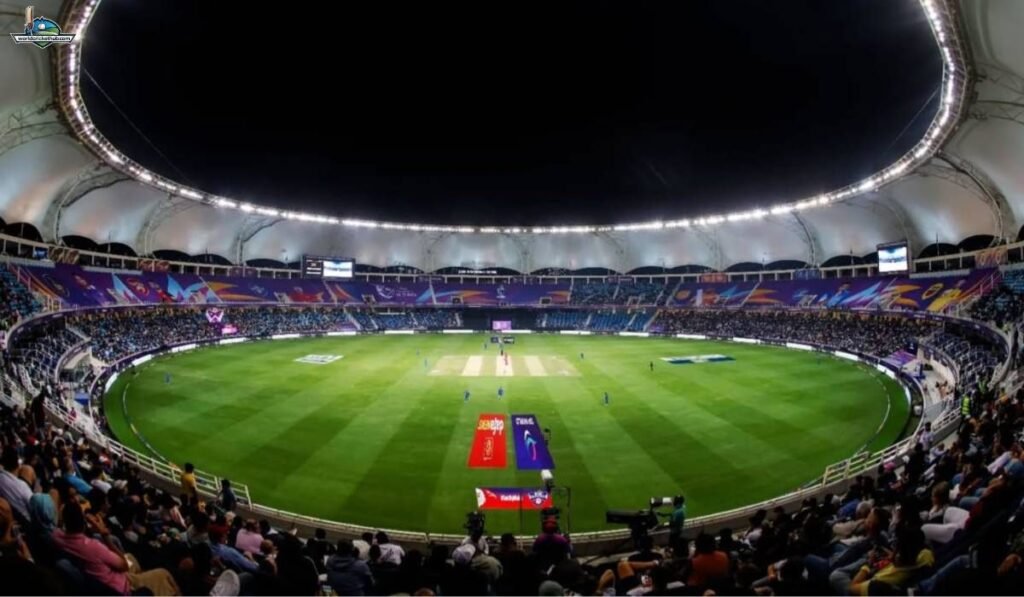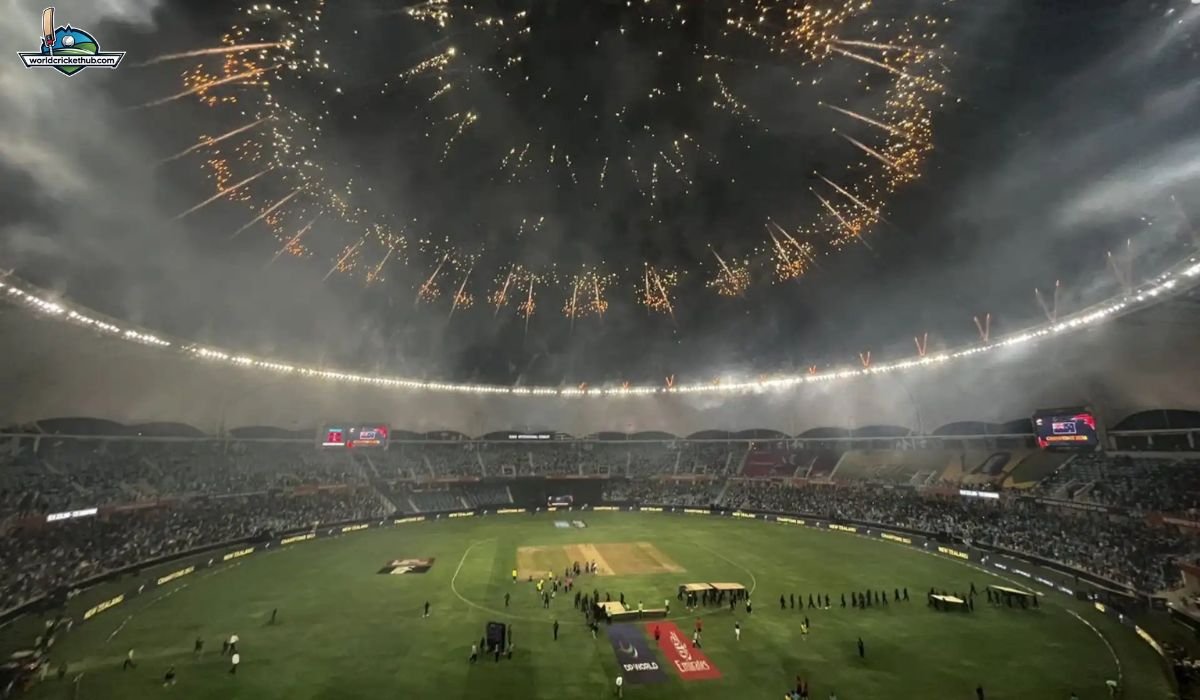The Dubai International Cricket Stadium is one of the three big cricket stadiums of the UAE, along with Sharjah Cricket Stadium and Sheikh Zayed Cricket Stadium. Previously named Dubai Sports City Cricket Stadium, this stadium has a seating capacity of 25,000 and will be expanded to 30,000. The Dubai Stadium has an innovative lighting system called the “Ring of Fire.” It was specifically constructed to light up the Dubai Cricket Ground. Its spherical dome minimizes shadows caused by objects below, and its 350 floodlights are circularly distributed, minimizing the number of floodlight towers needed. Shifting focus to the Dubai International Stadium Pitch Report, Dubai International Stadium has a balanced wicket when it comes to being batsman-friendly as well as bowler-friendly.
The pitch usually gets slower and a bit drier as the innings go on, particularly in the middle overs, allowing spinners to make an impact on the game. Pace bowlers can find a little seam movement with the new ball, especially under the lights, but batsmen struggle to be able to play big shots, hitting the ball freely due to the slow nature of the pitch. The toss has a big role to play in results; often, teams prefer chasing as the pitch is easier to bat on in the second innings.
Dubai International Stadium Pitch Report: How does the Dubai International Stadium Pitch behave?
In general, the pitch at the Dubai International Stadium is regarded as a decent surface, which allows both batsmen and bowlers to perform well. It is not generally a high-scoring ground, unlike many new grounds. Although the batsmen can play their shots with freedom on a surface that has an excellent bounce, it is often a relatively slower surface, and a drier one, at the end of the game. This slowing down causes the spinners to have an impact in the mid-overs, as they can find a lot of grip and spin. While the presence of dew in day-night games is also an important factor, it is often easier for the chasing side. The toss is often critical, and teams will usually prefer to bowl first to take advantage of the changing pitch and dew.
Dubai International Stadium Pitch Report: Pitch Behaviour in Tests
In a Test match, the Dubai International Stadium pitch is an interesting proposition for both sides, for it is neither the green top nor the dust bowl one is accustomed to seeing. While normally a reasonable batting wicket in the earlier phases of a Test match, batting conditions, as is typical for these pitches, will worsen during the match. Typically, the wicket in Dubai is devoid of any grass, meaning fast bowlers have a tough time in the first couple of days of a Test.
By the time the Test reaches the third or fourth day, spinners come into their own, primarily as a result of the dry and abrasive nature of the pitch (and as a consequence of footmarks on the pitch created by the bowling footfalls). A wicket can also assist the pacers in the final innings due to the abrasive and cracked surface, allowing for reverse swing. With all of the variations of drying surfaces, it becomes very important to win the toss and bat first, since teams will prefer to bat first and score on the best batting conditions, before leaving a scoreboard for batting conditions that are unsuitable on day 4 of the match.
Dubai International Stadium Pitch Report: ODI Pitch Behaviour

The pitch at the Dubai International Stadium offers a fair challenge for teams in ODIs in that runs are moderate; pitches are not often overly conducive to high totals, like many others around the world that would often yield totals well into the second hundred or higher. The average first innings score is typically in the low to mid-200s, which would suggest that a total of 250-280 would be competitive. Pacers may experience some initial movement with the fresh ball, particularly in the evening, but as innings go on, the pitch usually slows and dries.
This shift in the pitch reduces the rate of scoring, and increases the difficulty for the batters, particularly at the latter part of the innings; particularly the spinners are presented with much more difficulty in trying to get wickets and taking the game in the hand from the middle overs of the innings, as the spinners can get the ball to grip and turn towards the latter part of the innings. Dew would also be a major contributor to the day-to-night matches, and the manner in which the pitch plays would cause most teams (toss-winners) to choose to bowl first because it would facilitate easier chasing in day-to-night matches.
Dubai International Stadium Pitch Report: T20I Pitch Behaviour
The Dubai International Stadium T20I pitch is usually an evenly balanced surface that favors batsmen as well as bowlers. It does not favor scoring the highest total possible, as most average first innings totals range between 140 and 160. The slow-drying nature of the pitch makes it difficult for batsmen to come through the line and hit the rope. There is generally a great deal to be gained in the latter part of the game once spinners have gained a good hold and turn. The factor of dew in day-night games generally makes it much easier for the chasing team to accumulate runs. Thus, after winning the toss teams like to bowl first after winning the toss since this generally provides the better conditions.
Toss and Match Strategy Summary
The Dubai International Stadium toss is a critical part of match planning. With the slow track, especially in the latter part of the match and the effect of dew in day-night conditions, it is most prevalent and statistically prudent to win the toss and bowl first. Since teams like to chase in a day-night encounter, they can gain from the track easing out for batting. The chasing side has the advantage of knowing what they have to chase, and hence can structure their innings accordingly. In addition, if there’s dew, this will be an advantage for the batsmen over the bowlers, who already stand to lose with the declining pitch as the game wears on.
Historical Games and Significant Individual Performances
The Dubai International Stadium was a dynamic neutral international cricket venue, with a heap of games played and iconic performances in all three formats.
Test Matches
The Dubai International Stadium is a memorable venue for the Pakistan National Cricket Team, especially in test matches. One of the everlasting memories is the knock of 302* runs by Azhar Ali (triple century) against the West Indies in 2018. Also, Yasir Shah holds the best test bowling figure at this venue (14 wickets off 184 runs) against New Zealand in 2018.
ODIs
The ground of the Dubai International Stadium, especially in ODI, is where players have broken many records and showcased powerful performances. One of the memorable records is registered by Shahid Afridi for taking the most wickets in an innings (6 wickets for 38 runs) against Australia in 2009. On the batting side, Mushfiqur Rahim from Bangladesh has registered the highest individual score (144) against Sri Lanka in 2018.
T20Is
Dubai International Stadium itself has been the setting for T20 cricket, such as the IPL, PSL, ICC games, and more in 2023. It was Virat Kohli’s first century in T20I when he had an unbeaten 122 – a match against Afghanistan during the 2022 Asia Cup. More importantly, it was Kohli’s first century in international cricket since 2019. In the same match, India’s pace bowler Bhuvneshwar Kumar was at the other end of breaking records with a remarkable bowling spell of 5 wickets for 4 runs – one of the best recorded efforts in T20Is at this venue.
Conclusion
All in all, the Dubai International Stadium is unique in the way that the character of the pitch continues to change during a game. The slow and dry condition of the surface has a tendency to place great importance on strategy, batsmanship, and sometimes invokes spinners during the middle overs. This has made the toss a matter of dispute since teams prefer to bowl first in an attempt to have the opportunity for dew and better batting conditions during the second half of the game. Ultimately, this success is brought about on this terrain through a team’s ability to adapt to the constantly varying conditions rather than by sheer brute force, and so this is actually an ordeal of skill and strategy for cricket.
Read More: Dharamshala Cricket Stadium Pitch Report || Sheikh Zayed Stadium Pitch Report


